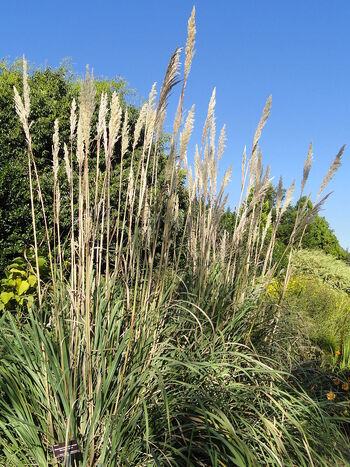| Ravennagrass | |||
|---|---|---|---|

| |||
| General information | |||
| Universe | Real Life | ||
| Aliases | Elephant Grass Ekra Ikora | ||
| Classification | Saccharum ravennae | ||
| Species type | Sugarcane | ||
| Homeworld | Earth | ||
| Environment | Moist or wet biomes such as marshes and riverbanks | ||
| Intelligence | Non-sapient | ||
| Biochemistry | Carbon-based lifeform | ||
| Discoverer | Carl Linnaeus | ||
| Biological information | |||
| Average height | 13 ft (4m) | ||
| Locomotion | Sessile | ||
| Feeding behavior | Autotroph | ||
| Lineage information | |||
| Cultural information | |||
| Alignment | True Neutral | ||
| Personality | Mindless | ||
| Organization | Dense clumps | ||
| Sociocultral characteristics | |||
| Scientific taxonomy | |||
| Planet | Earth | ||
| Domain | Eukaryota | ||
| Kingdom | Plantae | ||
| Subkingdom | Embryophytes (Land plants) | ||
| Infrakingdom | Polysporangiophyte (Sporophyte has branching stems that bear sporangia) | ||
| Superphylum | Tracheophytes (Vascular plants) | ||
| Phylum | Spermatophytes (Seed plants) | ||
| Subphylum | Angiosperms (Flowering plants) | ||
| Infraphylum | Monocots (Seeds typically contain only one embryonic leaf) | ||
| Class | Commelinids (Monocots whose cell walls contain UV-fluorescent ferulic acid) | ||
| Order | Poales (Grasses, bromeliads, and sedges) | ||
| Family | Poaceae (Grasses) | ||
| Subfamily | Panicoideae (Maize, sorghum, sugarcanes, and switchgrasses) | ||
| Genus | Saccharum (Sugarcanes) | ||
| Species | ravennae | ||
| Other information | |||
| Status | Least concern | ||
Ravennagrass, also known locally as Ekra and Ikora and one of three species referred to as Elephant Grass (Saccharum ravennae) is a species of perennial sugarcane indigenous to the grasslands of Southern Europe, Western and Southern Asia. It has been introduced to North America, where it is considered an invasive species, even to the point of being referred to as a "troublesome noxious weed" in places such as California the Glen Canyon region of Utah.
Description[]
Ravennagrass is an aggressive, tall-growing, erect-stem grass, growing upwards of 13 ft (4m) tall. Each serrated leaf can be up to a meter in length. The inflorescence is a plume-like panicle of spikelets covered in white or pale-colored silky hairs. It grows in large, dense clumps emerging from a network of rhizomes and grows in moist and wet habitats such as marshes and riverbanks.
Humans have been known to use the grass as a product to be sold as ornamental grass in gardens, and like similar species such as Napier Grass is used to stabilized soil to prevent erosion.